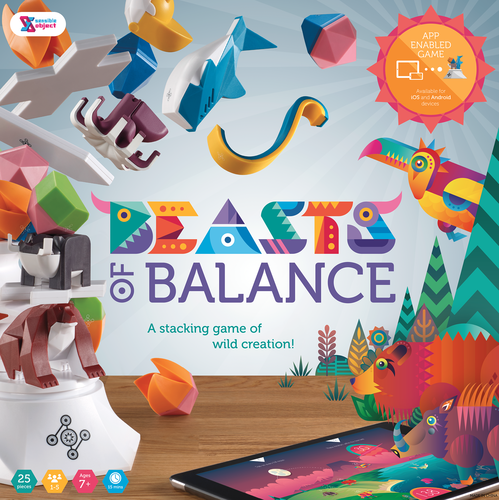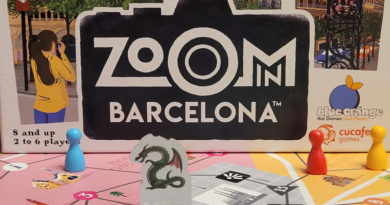Trekking the World 2nd Edition game review and comparison

Four years ago, just as people were starting to travel again after being cooped up for months for COVID, we reviewed a fun family board game by Underdog Games called Trekking the World.
So when we heard Underdog Games was publishing a new version of the game, we were more than eager to try it out. And now that it’s hitting store shelves, we’re happy to share the details with you.
While the premise remains the same as the original, Trekking the World 2nd Edition is much more streamlined and simplified to play. Not that the 1st edition is complicated. But this new version is even better for general family play.
We really like the changes made to the game.
We’ll give a quick overview of how to play Trekking the World 2nd Edition, then go into details on the many elements that have changed to make this fun family board game even better.
How to play Trekking the World 2nd Edition
Trekking the World 2nd Edition, as you might imagine, is a family board game about taking trips around the world. Players gain points by taking Tours, having Encounters, and collecting Souvenirs at different locations.

At the start of the game, the Tour card deck is shuffled and cut in half. One half will be placed art-side up to create the Tour deck. The other half will be placed text-side up to create the Encounter deck. Four cards from each deck will always be available to the players. The Itinerary deck is also shuffled and 5 cards are placed out face up to be available to players on their turns.
Each player takes a money tracker (set to 0) and a suitcase board for the souvenirs they collect during the game. Players also each start with a Frequent Flyer token.
Before a player’s first turn, they place their Trekker on any airport of their choice.
Moving and Collecting Souvenirs
On a player’s turn, they choose an Itinerary card from those on display, do what it says from top to bottom, then discard it. Each Itinerary card show 3 elements. At the top, it shows the exact number of spaces the player gets to move on their turn. Next, it shows how much money the player receives that turn (like an ATM withdrawl). Finally, if the player’s Trekker is on one of the continents shown at the bottom, they receive the indicated Souvenir cubes.
When moving, a player may use the airports as one of their movement steps but they must spend $1 to do so. They may also pass through or land on spaces occupied by other players.
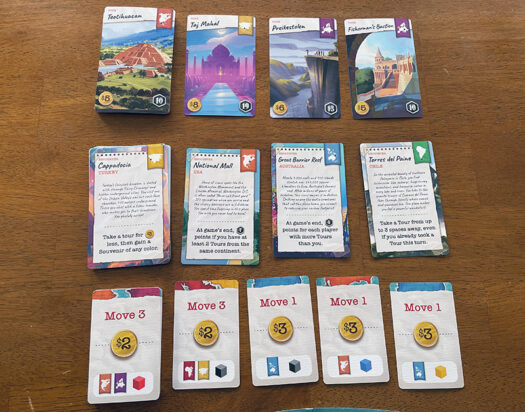
When adding a Souvenir cube to their suitcase, if it covers an icon, the player also receives the matching token for later use. The 4 tokens and their abilities are:
- Frequent Flyer – Use this token to fly from your current location to any airport. This must be done at the start of a turn, before choosing an Itinerary card.
- Move – Use this token to move one extra space.
- Money – When gaining money from an Itinerary, use this token to double the amount of money you receive.
- Souvenir – When gaining souvenirs on a turn, use this token to gain the same number and color of souvenir cubes again.
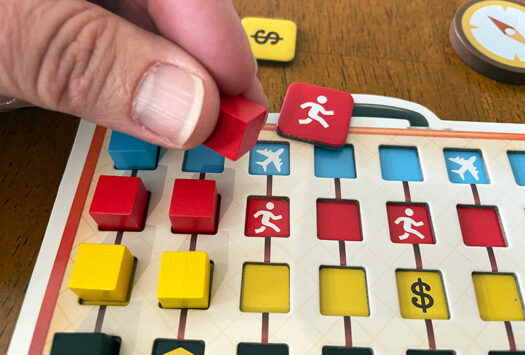
Having Encounters
After completing an Itinerary, if a player ends on the exact location matching one of the available Encounter cards, they get to take it. Each Encounter card grants a one-time use ability to that player. Once the player uses their ability on a future turn, they discard the card.
Some Encounter cards grant points at the end of the game. These cards are held to the end of the game rather than being used and discarded.
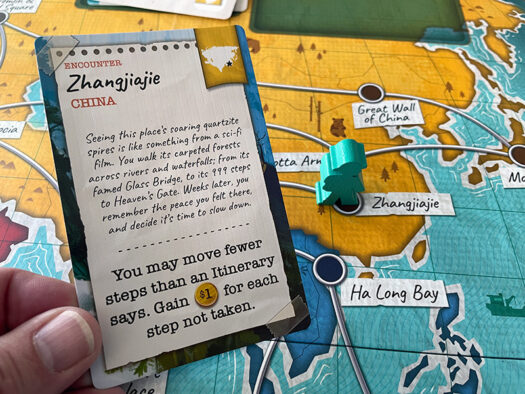
Taking Tours
Tour cards are the main way of gaining points throughout the game.
After completing an Itinerary, if a player ends on the exact location matching one of the available Tour cards, and if they have enough money, they may pay for taking that Tour. Once they deduct the amount from their Money tracker, they take the card and will get the indicated points at the end of the game.
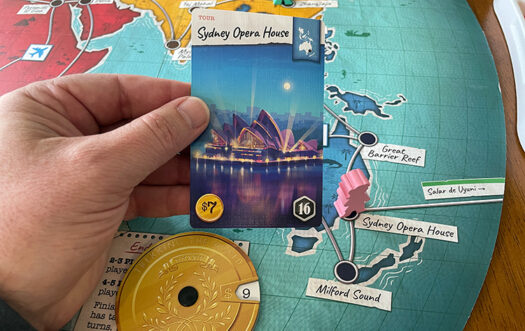
End of Turns and End of Game
After a player’s turn, any empty spaces in the card display are refilled by cards from the corresponding decks. Play then passes to the player on their left.
Once a player takes their 4th Tour (in a 4 or 5 player game), or their 5th Tour (in a 2 or 3 player game), the game end is triggered. Players complete the current round of turns and then total their points.
Points are awarded for:
- Tour cards taken
- Encounter cards granting end-game points
- Completed columns in their suitcase
The player with the most points wins!

Changes to the 2nd Edition
Just pulling the components out of the 2nd edition box, I could immediately tell many things had changed in the new edition. Sure, there’s still a map board of the world, Trekker meeples, large double-sided cards of each location on the map, colored cubes, and suitcases. But some of the components of the 1st edition are no longer in the game and new components have been added – such as money dials and Itinerary tokens.

Underdog Games has listed 3 of the biggest changes to the game:
- 2nd Edition is a drafting & racing game while 1st Edition was a set-collection & racing game.
- 2nd Edition features card powers that players get for free by going to different destinations.
- 2nd Edition has a solo mode and 1st Edition doesn’t.
But there are many additional changes that we happily endorse as well.

Moving and Paying
The most noticeable to us right out of the gate is how players move and collect things throughout the game.
In the 1st edition, players collect colored, number cards to their hand. They can use these cards to either move spaces on their turn or spend them as matching icons to take Tours. For example, the 1st edition destination cards have icons on the bottom that essentially show their “cost”. When at that location, players may turn in matching cards of those colors to take the Tour and get those points.
With the 2nd edition, players don’t have a hand of cards at all. Instead, they select an Itinerary card on the table which lets them move, collect money, and potentially collect cubes. And to take a Tour at a location, they simply spend from money they’ve accumulated.
We love this change!
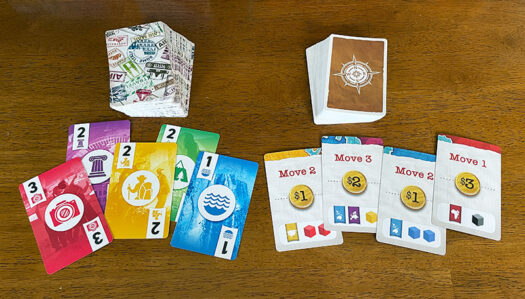
With the 1st edition, you have to be very judicious in which cards you play to move and which you keep to spend on Tours. With the new addition of money that you get on every turn, it’s much simpler to pay for taking a Tour when you get to a particular location. (Provided someone hasn’t beat you to it yet.) Now the choices are more about which Itinerary cards you choose because they grant different amounts of money.
You can choose to move further on a turn, but you’ll take less money. Or you can go for more money, but just move a single space. It’s a great balance of choices while also simplifying turns.
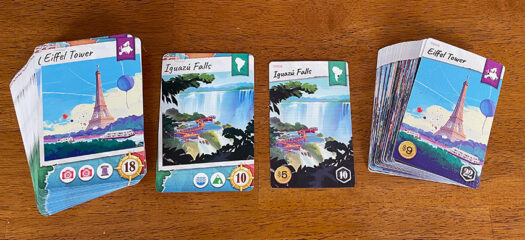
Souvenir collecting
Related to movement and Itinerary cards is the change to how Souvenir cubes are collected.
In the 1st edition, Souvenir cubes are randomly placed on every location on the board. If a player ends their turn on a location that has a cube, they collect it. If the cube is already taken, too bad.
In the 2nd edition, it’s pretty simple to collect Souvenirs. If you end your movement on a continent showing on the Itinerary card you chose, you get the indicated Souvenir cubes.

Not only do we get to collect more Souvenirs throughout the game, but we’re less frustrated by getting stuck out of collecting just because someone is a couple steps ahead of us on the board. And rather than having to plan our movements around the world to land on specific locations to snag a certain colored cube, we have more control over which colors we can collect by choosing from the 5 Itinerary cards on display.
Which means the big choices really come down to those Itinerary cards. There are 3 things to consider with that selection (move, money, cubes) and we love it. They aren’t tough choices, but they do make a difference in trying to get what we need and to where we need before others get there.
Itinerary tokens
Speaking of Souvenirs, when placed in your suitcase, they may grant you special abilities.
We love this addition too!
In the 1st edition, collecting Souvenirs are worth points at the end of the game based on completed columns in your suitcase. But that’s it.
In the 2nd edition, those points still exist. So it’s nice to collect a variety of cubes so you can complete more columns fully for more points. But in addition to that, when you cover icons in your suitcase, you get to take the corresponding Itinerary token. And on future turns, you can spend those tokens for additional goodies (extra movement, free flight, more money, more cubes).
It’s another reason why we like collecting souvenirs as we travel in Trekking the World 2nd edition.
BONUS: The new edition suitcases are also double-layerd cardboard with inserts for the cubes. So rather than sliding around, they’re more protected from bumps. So nice!

Encounters and special abilities
In the 1st edition, the destination cards are solely used for taking Tours and getting points. The back side has interesting information about the location which is fun to read. But it doesn’t serve a game play purpose.
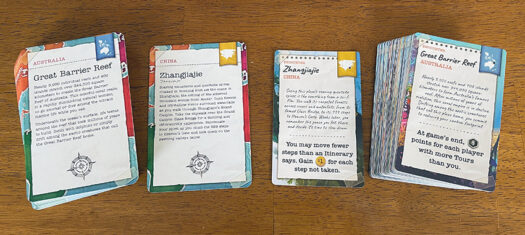
In the 2nd edition, the double-sided destination cards actually have a benefit on the back. Now, the back side of the card is called the Encounter side. Each game, all these cards are split so that half will be used for Tours and the other half will be used as Encounters.
When ending a turn at a location, if there’s an Encounter card on display that matches, the player takes the Encounter. And at the bottom of each card is a special ability that the player can use later.
The 1st edition does have some special abilities. They are called Journey cards and 2 are randomly set up each game. Players need to spend two cards from their hand to use one of the abilities. With these new Encounters, there’s a lot more abilities players can use throughout the game without needing to pay with cards. Much more fun and feels more strategic.
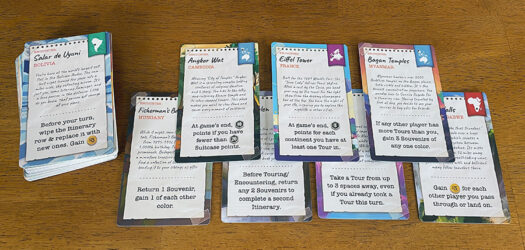
Bonus points eliminated
Usually bonus points are a great thing.
However, we’re happy to see the bonus point options in the original Trekking the World are gone.
There are two ways to gain bonus points in the 1st edition.
The first is through Region Bonuses. If a player collects the last cube from a location on a continent, they get the Bonus Token next to that continent. These tokens are randomly set up at the start of the game and feel arbitrary. If you are lucky enough, you could snag it. But just like the randomness of collecting cubes from locations to begin with, this feels like it unfairly grants points to a player. Yes, it encourages players to move to every location collecting cubes, but that feels ancillary to setting out for specific locations to take Tours.

The other way to gain bonus points in the 1st edition is through Souvenirs. The player that gains the most of a particular souvenir is granted bonus points for doing so. Different colors grant different points for having the most. For example, yellow cube majority grants 12 points and black majority grants 9 points.
But again this falls prey to the randomness of collecting cubes and for a first-player advantage – who can race out collecting cubes before others.
As such, by eliminating these extra points to arbitrarily chase, the 2nd edition is more streamlined and focused on the theme of the game. We don’t miss those extra points at all as the point spread among players at the end of the game is still close each time.
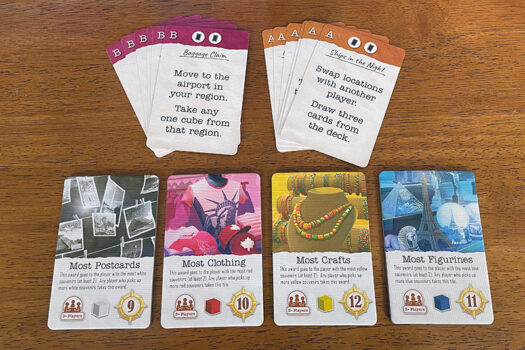
Easier to move around
In addition to the simplified way movement is handled (by choosing an Itinerary card rather than playing cards from your hand), actually moving around the board is even more family-friendly in the 2nd edition because of two major rule changes.
The first big rule change is that player’s Trekker meeples don’t block other players!
In the 1st edition, if another player’s Trekker is on a location, you can not move on or through it. They block your route completely.
In the 2nd edition, you can freely move to and through spaces occupied by other players. This is a welcome change for general family play. It’s also a lot more in keeping with the travel theme of the game. After all, just because someone else is at the Eiffel Tower, doesn’t mean I can’t visit it as well.
The other movement rule change that simplifies travel is the use of airports.
In the 1st edition, if you start your turn on an airport space, you may Fly to another airport before you begin your movement that turn.
In the 2nd edition, you may fly from one airport to any other airport at any point during the your movement that turn for the cost of $1. It still counts as one of your points of movement, but it will cost you some money. Very little money, but still it costs something. Yet it grants you much more freedom in being able to traverse the board during your turns without a ton of pre-planning future turns.
Another way to fly is with the use of Frequent Flyer tokens. They’re the blue Itinerary tokens you can gain by placing blue souvenir cubes over the airplane icon in your suitcase. And each player starts the game with 1 of these tokens. Players can spend a token to Fly from wherever they are to any airport location. It can come in very helpful when you’re ready to make a big play in the game.
Solo mode
Over the past several years, many game designers have added options for playing board games solo. And Trekking the World 2nd edition has such a game mode.
When players are interested in taking on the game challenge by themselves, this is a great option.
There are 4 different difficulty levels to choose from. The Difficulty card indicates how many Tours the player must take and how many souvenirs they must collect to win. It also lists a Tourist Tax which is an amount that must be paid to take an Encounter at a location if a Tourist Trekker is also at that location.
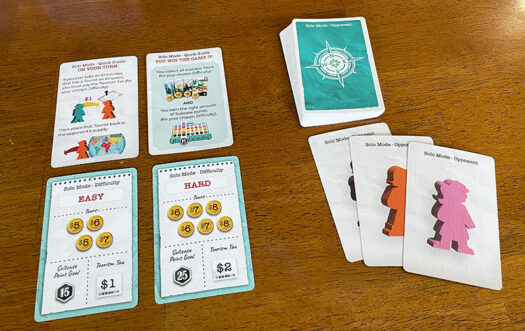
The game play alternates between the player and the 4 other Trekkers.
The player takes turns as in the normal game. However, when it’s the Tourist turn, the player flips a card from the Tourist card deck. It shows a color of Trekker to act that turn. If that Trekker is already on the board, it will take the Encounter card matching its location. If that Trekker is not on the board, it gets placed on the location matching the leftmost Encounter not occupied by another Tourist. Thus it essentially takes one Trekker color two turns to get on the board then claim an Encounter.
If the Tourists collectively claim 7 Encounter cards or their draw deck runs out, the Tourists win and the player loses the solo game.
If the player collects enough Tours and Souvenirs as indicated on their Difficulty card, before the Tourists hit their mark, the player wins.
I typically don’t play solo mode with board games. But I did give it a go in Trekking the World 2nd edition and rather enjoyed it.
It’s definitely a race to claim Tours while Tourists keep popping up all over the board and taking cards. But it’s fun to swipe Encounter cards out from under them when possible, even if it requires paying the Tourist Tax. Totally worth it.

Our verdict on Trekking the World 2nd Edition
Trekking the World 2nd edition wins out for us hands down!
We love the streamlined play that’s more fitting for the travel theme of the game. There are still plenty of choices to consider and tradeoffs to make as we race around the world to keep it interesting. Yet, it’s much more approachable than the 1st edition.
As you can see, we really like the fluid movement, more souvenir collecting, gaining and paying for Tours with money, the Encounter card abilities, and the tradeoffs when choosing Itinerary cards for movement, money, and cubes.
As such, our 1st edition copy of the game is now looking for a new home as we hang on tightly to our copy of Trekking the World 2nd edition.
The Board Game Family would like to thank Underdog Games for a review copy of Trekking the World 2nd Edition.
Don’t miss the next awesome game for your family! Subscribe to The Board Game Family reviews and articles.
SUBSCRIBE
As an Amazon Associate, we earn from qualifying purchases from Amazon.com links.




